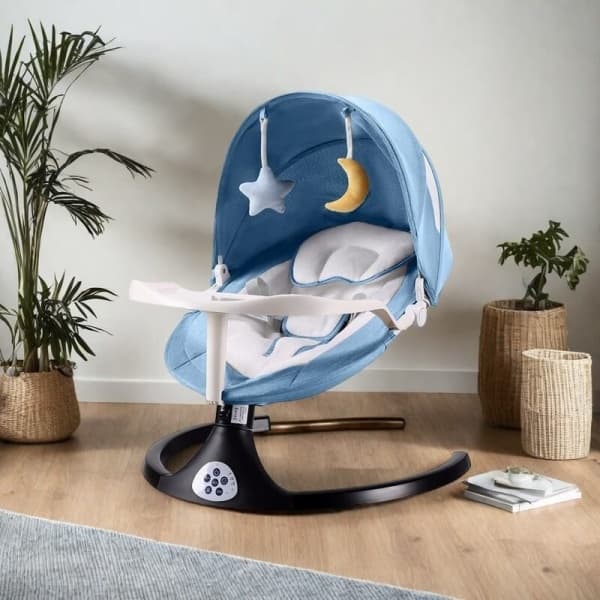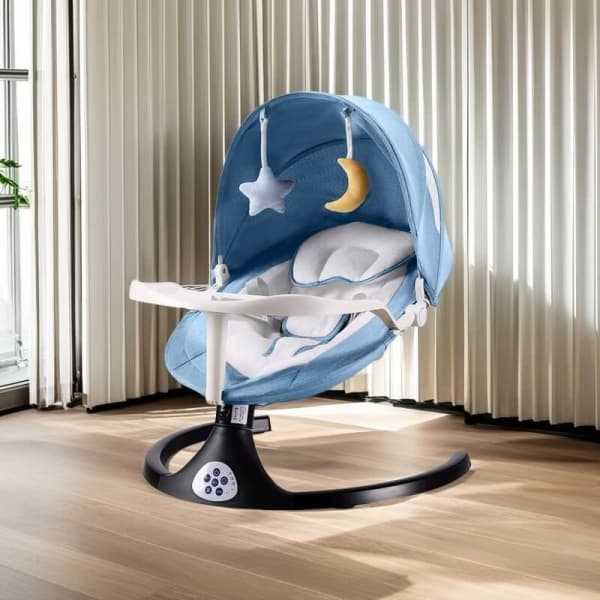Baby swings is a very functional baby gear, if you don’t watch out for your child’s safety, it might quickly go wrong. And to do this, you must be mindful of the baby swings’ weight limit before buying them.
Exceeding the weight limit can lead to safety hazards and discomfort for your child.
In this article, we’ll explore the functions of baby swings, typical weight limits, and the potential consequences of exceeding them. We’ll also cover important safety advice for parents to heed and how to tell when your child has outgrown the swing.
What is the Function of a Baby Swing?
A baby swing is a piece of equipment for babies that is made to rock or sway them gently back and forth or side to side. This motion can assist in entertaining and soothing babies.
A baby swing’s usual construction includes a padded seat that is supported by a strong frame. They frequently have a safety harness, seat covers that can be removed, and a portable design, among other characteristics. Infant swings can be made to accommodate an infant’s needs by having reclining positions, sounds, and speed adjustments.
Baby swings come in a variety of types, including full-size swings and compact or travel swings, and they can be powered by batteries or connected to an electrical outlet.
Benefits of Baby Swings to Children and Parents:
- Offers a calming rocking motion: The rhythmic motion can help calm fussy newborns and facilitate their fall asleep by simulating a similar comfort as of being in the womb.
- Safe play space: Swings offer a safe space for infants to unwind and take in their surroundings, promoting safe exploration.
- Provide much-needed hands-free time: enables parents to focus on themselves, take care of other responsibilities, or relax knowing their infant is secure and amused.
- Encourages routine: Parents may better control their baby’s sleep and play schedules by using a swing to help create calming routines.
- Aid in stimulating sensory development: the gentle rocking motion of baby swings can encourage vestibular development, which is critical for coordination and balance.
What Is the Weight Limit for Baby Swings?
Depending on the design and manufacturer, most standard swings can support babies weighing 20 to 30 pounds. Standard swings are more robust, have more swinging motions and speed, and frequently take up more room.
Compared to standard swings, portable swings typically have lower weight limitations because they are made for portability and convenience. Parents who are constantly on the go may find these swings helpful because they are lightweight and small, but they can often hold babies weighing up to 15 to 25 pounds.
Although practical, they may not last as long as a full-sized swing and are better suited for smaller or lighter infants.
Baby swing weight limits are determined by a number of factors, such as the swing’s material and strength. This implies that a baby swing may support more weight if it is stronger or the material is of higher quality.
The weight limits of many infant swing brands vary. Remember that the upper weight restriction is only an estimate and may vary depending on the manufacturer and model.
Before purchasing, always check that the weight limit listed by the baby swing manufacturer fits the weight of your unborn child. Here’s a breakdown of the weight capacities of popular baby swing brands:
| Brand | Maximum weight Restriction (Pounds) |
| Clafbebe | 30 |
| Graco | 30 |
| 4moms | 25 |
| Chicco | 20 |
| Fisher-Price | 25 |
| Ingenuity | 20 |
| Bright Starts | 20 |
| Mothercare | 20 |
| Stokke | 20 |
| Peg Perego | 30 |
Notably, It is dangerous to place your kid in the swing if their weight is higher than the maximum or lower than the minimum. Thus, one of the most important ways to guarantee a healthy swing experience is to periodically check your baby’s weight and gauge how comfortable they are in it. Also, remember to check with your doctor about the safety of using a baby swing if your child is premature.
What Happens if You Exceed the Weight Limit?

Exceeding the weight limit of a baby swing can have serious consequences, both for the child and the equipment.
- Safety risks to the baby: If a swing is overloaded, it can become unstable and easily tip over or collapse, increasing the risk of injury to the baby.
- Decreased effectiveness: If the weight capacity is exceeded, the swing may not operate as smoothly. The infant may experience discomfort if the motor is unable to sustain a consistent swinging action, resulting in jerky or uneven motions. The swing’s calming effects may be diminished for heavier babies since they may find it difficult to move.
- Wear and tear on the device: Swings are made to support a given weight using particular materials and structural integrity. Components including the suspension, harness system, and frame may deteriorate as a result of overloading.
- Warranty void: If a product is misused because of excessive weight, the warranty may be annulled, and you will not be covered for repairs or replacements.
Most baby swings come with clear warnings regarding weight and usage guidelines. It’s crucial to keep in mind that manufacturers base weight restrictions on thorough testing. These rules are in place to protect your child’s health and safety.
As a result, maintaining these boundaries is essential to creating a secure and cozy atmosphere. If your infant is getting close to the weight restriction, think about switching to different entertainment or soothing options that better fit their developing needs, including a robust high chair or a playpen.
Signs Your Baby Has Outgrown the Swing
Physical discomfort: It’s probably time to move your infant out of the swing if you observe their head or legs pressed against the sides or if they appear cramped in the swing.
Increased Activity: As soon as your baby can roll over, crawl, or pull themselves up, it’s imperative that you move them to safer play spaces that encourage mobility and discovery. Increased mobility can easily lead to tipping or slipping off the swing.
Lack of Interest: The swing may no longer be effective as a calming aid if your infant exhibits signs of boredom or discomfort. Infants are curious. They always want to try something new.
Age limit exceeded: most infants outgrow the swing between six and nine months to two years of age. However, as the baby’s growth fluctuates, pay closer attention to their weight. This is because babies may get too strong and hefty for the swing’s intended weight.
Dependency on motion: If your baby depends a lot on swings for sleep, you may need to transition them to more sustainable sleep practices, such as crib training, since prolonged prone swinging increases the risk of SIDS and flat spots on his head.
Safety Tips for Using a Baby Swing
You must follow safety instructions when using a baby swing. Although uncommon, newborns have suffered injuries and even lost their lives as a result of dangerous behaviors when using baby swings.
Because of this, the American Academy of Pediatrics has created a set of safety guidelines that all parents should adhere to when using baby swings.
Secure the harness well: Use the harness system to fasten your infant in the swing. Use the straps as directed and don’t skip any. As your baby gets bigger, don’t forget to modify the harness. It shouldn’t be too tight, but it should fit well.
Use under supervision: Never leave your infant in the swing alone, not even for a little period of time. To guarantee their safety, always keep an eye on them when they’re utilizing it.
Position the swing properly: To prevent tipping, position the swing on a level, sturdy surface. Keep it away from stairs and uneven floors.
Limit how long you use the baby swing: Infants should only spend 15 to 30 minutes at a time on a swing. Since newborns require time on the floor to practice motor skills like rolling, crawling, and sitting up, spending too much time in a swing might cause developmental problems.
Examine for Wear and Tear: Frequently look for signs of deterioration, such as fraying straps or loose screws, on the swing. To make sure the swing works properly, tighten any screws or bolts and, if necessary, replace the batteries.
Conclusion
Baby swings are a valuable tool for soothing infants and providing parents with hands-free time, but responsible use is key.
Understanding the swing’s purpose, weight restrictions, and the possible repercussions of going over them will help you make decisions that will benefit both you and your baby’s health.
For a wide range of safe and stylish wholesale baby swings for your business or store, visit baby product manufacturer Clafbebe today to find the perfect swing for your needs!
Recommended Related Articles:














